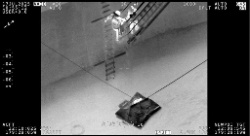River Management Teams Drowning In Work Following Cyclones
Slips, river erosion protection works ripped out, blocked rivers, river channels off course, debris and silt buildup, river flood capacities compromised – this summer’s flooding has left behind a substantial trail of damage for Waikato Regional Council to remedy for its communities.
Across the region, the estimated cost due to damage from the flooding events is nearly $18.5 million.
All areas presenting immediate high risk of flooding to communities and properties are being done as a priority before June 2023 with further remedial work to continue in the following two years.
One job of high priority is remediation works to the Ohinemuri River in Paeroa, beneath the Criterion Bridge, currently underway. The river, the largest tributary of the Waihou River, is part of the Waihou Valley flood protection scheme.
Works supervisor Hayden McGregor, from the council’s Paeroa office, says major silt deposits accumulated on the inside corner (south side) of the river under the bridge during the floods significantly reduced the volume of water that could pass under the bridge.
“As a result of the river having to make room for itself, it eroded a lot of the river berm in the front of the stopbank that protects the town. So, we’re creating some rock armouring to the riverbank to prevent any further erosion and loss of bank.”
Up to a metre of silt was also removed from the surface of the berm on the downstream, south-side of the bridge to improve future flood capacity of the river within the town’s two stopbanks.
The unseasonably wet summer caused extensive damage to multiple rivers and streams in the Coromandel Peninsula and Hauraki catchments, and to a lesser extent in the lower Waikato/west coast.
Cleaning up has been the immediate focus of the council’s river management teams, so removing trees from the rivers as they cause blockages that exacerbate damage, and realigning river channels.
Coromandel Catchments Lead James Ferrier-Kerr says the events of the summer have culminated in the worst, widespread damage he has experienced in his seven years working in river management in the peninsula.
“A big part of the Coromandel story is the successive heavy rain events we’ve had in May, July, September, November, December, followed by Hale, Auckland Anniversary weekend in January then Gabrielle for three days in February,” says James.
“When Gabrielle made landfall, we were already in a state of catchment saturation with obstructions and bank erosion sites known but unable to be remedied between events. Since Gabrielle, we continued to have localised heavy rain in March and April.”
James says the priority has been clearing obstructions to mitigate the flood and erosion risk before starting on erosion protection works. Logistics have been difficult on the peninsula with road closures.
“We estimate a further 12 months of remedial works. We have completed 34 out of 88 clearance jobs and landowners are still making contact. We’re spending days if not weeks on the same property. As an example, we cleared multiple obstructions over 3.6 kilometres from the Whenuakite River which took four weeks and there is a further 3.4 kilometres of the Whenuakite River that requires work.
In the Hauraki area, the flood management team has also been making its way clearing obstacles along rivers and realigning channels.
“Basically, we’ve been working from the bottom of a river up, doing what needs to be done” says Hayden of the Komata, Hikutaia and Puriri rivers, also tributaries of the Waihou River, and the Kauaeranga River, which is the third largest river system within the Waihou Valley Scheme.
Along the Hikutaia River, many of the old poplars dropped their branches into the river so, as well as clearing the blockages, staff are coppicing the trees, with the timber being sold to help cover some costs.
“The extent of the damage to our rivers is quite incredible. On some river corners, significant amounts of land have been lost.
“The Komata River basically jumped its channel and crossed the road in places.
“We get rid of all the branches in the river and get the diggers in to reinstate channel stability as soon as possible. The last thing you want is a slip remaining in the river over an extended period of time.
“Pools do naturally occur in streams and rivers, so we want the digger driver to not create big wide shallow channels. Pools are habitat for fish, and they also provide refuge during high flows. Sometimes I might have to say, ‘I know you have done a nice tidy job, but can you mess it up for me, please’.”


 Gordon Campbell: On The Costs Of Regulating Cost, And Burkina Faso As A Role Model
Gordon Campbell: On The Costs Of Regulating Cost, And Burkina Faso As A Role Model Dog Lovers of Monte Cecilia: Locals Challenge Puketāpapa Local Board And Auckland Council’s On-Leash Policy Change For Monte Cecilia Park
Dog Lovers of Monte Cecilia: Locals Challenge Puketāpapa Local Board And Auckland Council’s On-Leash Policy Change For Monte Cecilia Park Maritime New Zealand: Three Rescued In High-Seas Operation After Vessel Abandoned North Of New Zealand
Maritime New Zealand: Three Rescued In High-Seas Operation After Vessel Abandoned North Of New Zealand Health Coalition Aotearoa: Experts Urge Fix As Government Expands Failing Lunch Scheme To Primary Schools
Health Coalition Aotearoa: Experts Urge Fix As Government Expands Failing Lunch Scheme To Primary Schools Helen Clark Foundation: The Helen Clark Foundation Launches Honorary Fellow Programme
Helen Clark Foundation: The Helen Clark Foundation Launches Honorary Fellow Programme Department of Conservation: Call For Public Information On Auckland Marine Mammal Cases
Department of Conservation: Call For Public Information On Auckland Marine Mammal Cases New Zealand Jewish Council: NZ Jewish Council Clarifies Position - Advocating For Safety And Accountability, Not Censorship
New Zealand Jewish Council: NZ Jewish Council Clarifies Position - Advocating For Safety And Accountability, Not Censorship


